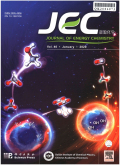- 钛学术文献服务平台 \
- 学术期刊 \
- 工业技术期刊 \
- 石油与天然气工业期刊 \
- 能源化学期刊 \
Ultralow-strain Ti substituted Mn-vacancy layered oxides with enhanced stability for sodium-ion batteries
Ultralow-strain Ti substituted Mn-vacancy layered oxides with enhanced stability for sodium-ion batteries
基本信息来源于合作网站,原文需代理用户跳转至来源网站获取
摘要:
Anionic redox reaction (ARR) in layered manganese-based oxide cathodes has been considered as an effective strategy to improve the energy density of sodium-ion batteries.Mn-vacancy layered oxides deli-ver a high ARR-related capacity with small voltage hysteresis,however,they are limited by rapid capacity degradation and poor rate capability,which arise from inferior structure changes due to repeated redox of lattice oxygen.Herein,redox-inactive Ti4+ is introduced to substitute partial Mn4+ to form Na2Ti0.5Mn2.5O7 (Na4/7[□1/7Ti1/7Mn5/7]O2,□ for Mn vacancies),which can effectively restrain unfavorable interlayer gliding of Na2Mn3O7 at high charge voltages,as reflected by an ultralow-strain volume varia-tion of 0.11%.There is no irreversible O2 evolution observed in Na2Tio.5Mn2.5O7 upon charging,which sta-bilizes the lattice oxygen and ensures the overall structural stability.It exhibits increased capacity retention of 79.1% after 60 cycles in Na2Tio.5Mn2.5O7 (17.1% in Na2Mn3O7) and good rate capability(92.1 mAh g-1 at 0.5 A g-1).This investigation provides new insights into designing high-performance cathode materials with reversible ARR and structural stability for SIBs.

推荐文章
Ti含量对Al-Mn合金铸态组织的影响
Al-Mn
Al-Mn-Ti
准晶
铸态组织
Adsorption characteristics of copper ion on nanoporous silica
Nanoporous silica
Copper ion
Adsorption
添加Ti0.9Zr0.1Mn1.5复合球磨对Ti9.6V86.4Fe4 合金储氢性能的影响
储氢合金
复合物
复合球磨
相结构
Ti-Al系电子结构及Mn掺杂对TiAl3室温脆性的影响
密度泛函
TiAl合金
Mn掺杂
室温脆性
内容分析
关键词云
关键词热度
相关文献总数
(/次)
(/年)
引文网络
引文网络
二级参考文献 (0)
共引文献 (0)
参考文献 (0)
节点文献
引证文献 (0)
同被引文献 (0)
二级引证文献 (0)
2021(0)
- 参考文献(0)
- 二级参考文献(0)
- 引证文献(0)
- 二级引证文献(0)
引文网络交叉学科
相关学者/机构
期刊影响力
能源化学
主办单位:
中国科学院大连化学物理研究所
中国科学院成都有机化学研究所
出版周期:
双月刊
ISSN:
2095-4956
CN:
10-1287/O6
开本:
出版地:
大连市中山路457号
邮发代号:
创刊时间:
语种:
eng
出版文献量(篇)
2804
总下载数(次)
0
总被引数(次)
7996
期刊文献
相关文献
推荐文献
- 期刊分类
- 期刊(年)
- 期刊(期)
- 期刊推荐
一般工业技术
交通运输
军事科技
冶金工业
动力工程
化学工业
原子能技术
大学学报
建筑科学
无线电电子学与电信技术
机械与仪表工业
水利工程
环境科学与安全科学
电工技术
石油与天然气工业
矿业工程
自动化技术与计算机技术
航空航天
轻工业与手工业
金属学与金属工艺
能源化学2022
能源化学2021
能源化学2020
能源化学2019
能源化学2018
能源化学2017
能源化学2016
能源化学2015
能源化学2014
能源化学2013
能源化学2012
能源化学2011
能源化学2010
能源化学2009
能源化学2008
能源化学2007
能源化学2006
能源化学2005
能源化学2004
能源化学2003
能源化学2002
能源化学2001
能源化学2021年第9期
能源化学2021年第8期
能源化学2021年第7期
能源化学2021年第6期
能源化学2021年第5期
能源化学2021年第4期
能源化学2021年第3期
能源化学2021年第2期
能源化学2021年第12期
能源化学2021年第1期

 免费查重
免费查重










